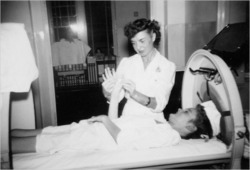Last Sunday, the New York Times Magazine ran a series of articles on notable people who had died during 2009 – most well known, a few not. It was the story of one of those lesser-known people that caught my eye, and that gives particular meaning, I think, to this day.
Her name was Martha Mason, of Lattimore, North Carolina. She was born in 1937, and when she was just 11 years old, she and her 13-year-old brother were stricken with polio. Her brother died in a matter of days.
But Martha lived.
 Within a few months, however, she became a helpless cripple. The disease left her a quadriplegic. After spending a year in the hospital, she was sent home in an iron lung – a massive machine that resembled a coffin, but that was equipped with pumps that made her lungs work. The doctors told her mother to keep the girl comfortable and happy. She would probably be dead by the end of that year.
Within a few months, however, she became a helpless cripple. The disease left her a quadriplegic. After spending a year in the hospital, she was sent home in an iron lung – a massive machine that resembled a coffin, but that was equipped with pumps that made her lungs work. The doctors told her mother to keep the girl comfortable and happy. She would probably be dead by the end of that year.
But – confounding every expectation — Martha lived.
She lived not just that year, but the next, and the next, and the next. Her high school teachers brought her lessons every afternoon. She studied hard, got good grades, and graduated. After she graduated, her parents moved with her to a nearby junior college, and then to Wake Forest University, where she attended class by intercom. Martha dreamed of being a writer. When she could, she would dictate feature stories to her mother, who would type them up for publication in the local paper.
Against all odds, Martha lived an astonishingly productive life. She gave dinner parties at her parents’ home, with the iron lung pulled up to the table. She read books with an electronic page-turner and watched videotapes. In the 1990s, she was able, through computers, to use a phone, turn on lights – and finally, to write. She poured her life story into a memoir called “Breath: Life in the Rhythm of an Iron Lung.” Around this time, her mother became sick after a series of strokes. Martha Mason managed her mother’s care, remembering how much her mother had cared for her.
By the time she died, Martha ended up spending 61 years in an iron lung – possibly, a world record. Yet she considered her life to be one of great joy. “I live in a stable of nightmares,” she once wrote, “but hope keeps them in harness.”
On this first day of a new year, I think Martha Mason’s story is profoundly beautiful testament to living – to confronting challenges, and pain. But also to living a life of possibility. And hope.
And possibility and hope lie at the heart of this feast day. The church, in her wisdom, has chosen this particular day to celebrate Mary as the Mother of God – the New Eve who gave birth to possibility, and brought forth our great hope. Through her, the human race was reborn, revived, redeemed. Through her, we are all able to begin again.
And isn’t that what New Year’s is all about?
Of course, we’ve reduced this day to hangovers and resolutions. It’s the day for sweeping up the confetti, and watching football games and promising to walk a mile on that treadmill that you found under the Christmas tree last week. By the end of the month, the treadmill will be a display case for potted plants. So much for resolutions.
But if you want to make resolutions, the great model for us all is, in fact, the woman we honor today. If we want to truly transform our lives, we can do no better than to resolve to live more like Mary.
Resolve to accept angels when they come into our lives, announcing the impossible.
Then, resolve to remember that nothing is impossible with God.
Resolve to welcome strangers – the shepherds of our own world who show up unexpectedly in our lives.
Resolve to live in wonder, and humility, and trust.
Resolve to keep all things, and reflect on them in your heart.
And resolve, my friends, to live in possibility, and in hope.
That is what it means to live like Mary, really. It is to embrace the divine, and welcome it, and not be afraid of what is to come.
And that is what this first day of a new year really means. It is an opportunity to begin again – to cherish more deeply the life we have been given, by honoring the one who gave life to our salvation.
The fact is: when we honor the Mother of God, we honor as well the gift of life. At a time when that gift is increasingly under attack, my hope and my prayer is that we can each strive to defend that gift, to protect it, to cherish it. And to do that, the best place to start is with ourselves.
Let us resolve, on this first day of a new year, to make our lives matter.
Let us resolve, like Martha Mason, to make every breath count.
